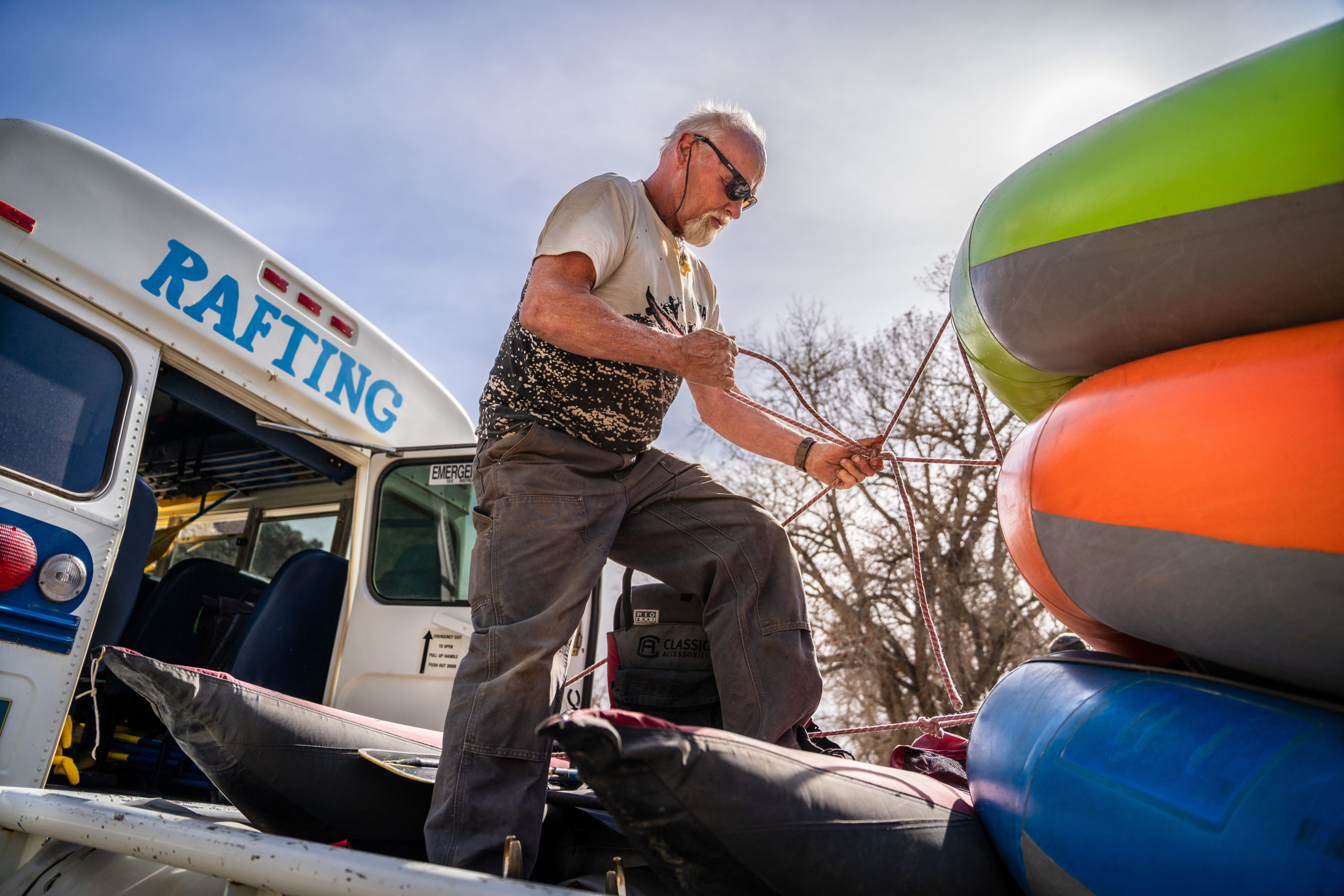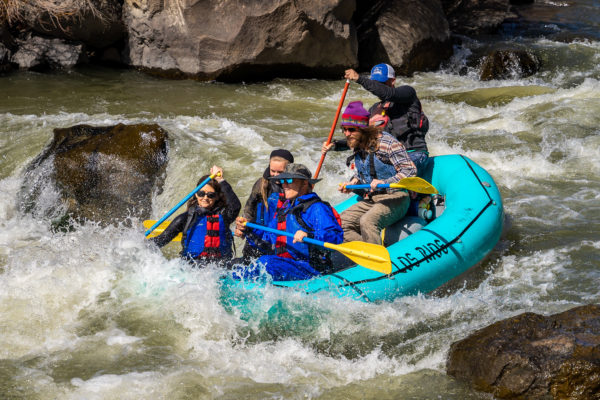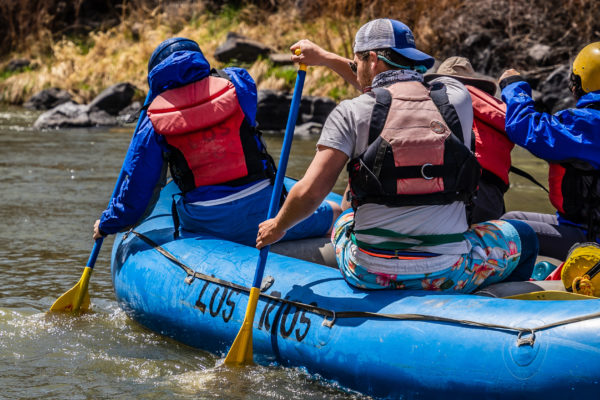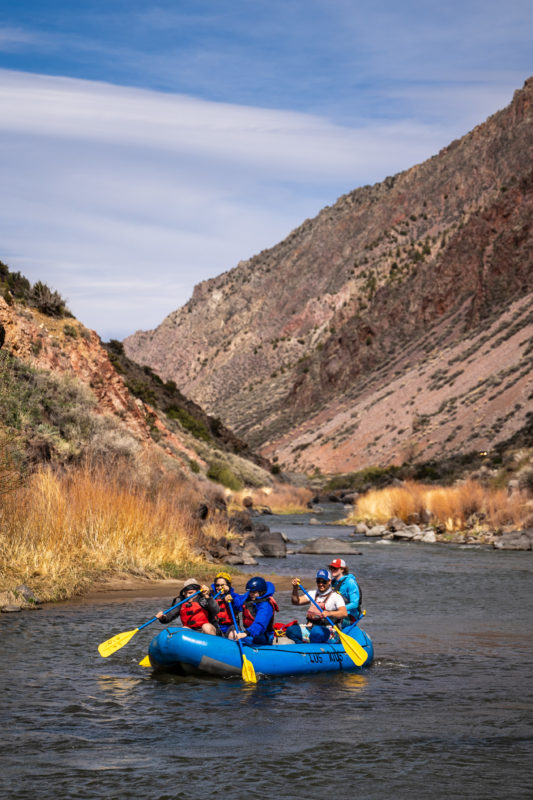Fun and rejuvenation for the spirit with the rapids coming fast and the spray up all around, there is little time to talk.
by Cindy Brown

With the rapids coming fast and the spray up all around, there is little time to talk. We are entering the Souse Hole: the last large rapid on the Racecourse section of the Rio Grande. The black basalt rocks loom up ahead and river guide Che Pirozak-Lillick calls out “Forward one. Again. Again,” and we paddle, attempting to maneuver our raft into the correct position to pass through Souse Hole without flipping over.

Rafters navigate the Souse Hole, a large rapid on the Racecourse section of the Rio Grande on Friday (March 25). Guided by Los Rios River Runners Pirozak-Lillick and James Collins, two guide interns and Taos News writer Cindy Brown enjoy their first time on this section of the river in early Spring.
We already know that many of the rafts that pass through this section in some water conditions flip in the hole. After making it through several other challenging rapids, we are paddling together well and have come to trust our guide to get us through safely, but the tension builds as we near the drop and we grip our paddles, ready to change our course in an instant.
Now we can see the glassy smooth water before the big drop and hear the roar of the rapids just beyond. Hitting the rapid straight on, our raft drops down into the hole of churning, foaming waves splashing everyone with a cold surge of river water. Then, the front of the raft pops up into the air, and we are through; wet, but happy to have made it without anyone falling out of the boat or flipping upside down.

Rafters navigate the Souse Hole, a large rapid on the Racecourse section of the Rio Grande on Friday (March 25). Guided by Los Rios River Runners Pirozak-Lillick and James Collins, two guide interns and Taos News writer Cindy Brown enjoy their first time on this section of the river in early Spring.
The Racecourse
Our river trip early in the 2022 season includes two seasoned guides with Los Rios River Runners, Pirozak-Lillick and James Collins, along with two interns, Kayla Dunkel from Florida and Daniel Sage of North Carolina. The Racecourse is one of the most popular river trips on the Rio Grande. At about five miles long, it has a mix of moderate to more challenging rapids and is generally appropriate for those age six and up, with the age rising to 12 or above in high water. The river guides become experts in “reading the river”
and navigating the right line to avoid collisions with rocks and turning the rafts upside down.
This is the first time on the Rio Grande for the interns, and they approach the trip with a mix of excitement and nervousness. They will have to run this section more than 20 times and prove their expertise before they are allowed to guide river guests. They listen to the safety briefing given by Pirozak-Lillick, knowing that someday their chance will come to do the same when they guide their own trips.

We learn that if we fall out of the raft, we should try to stay near the boat and if that’s not possible, to keep our feet up and face down the river, letting our life jackets keep us afloat. Perhaps most important of all, we learn to avoid the hazard of putting our feet down on the river bottom where a foot might get caught in the rocks.
Since our put-in at Quartzite Site, named for the pink and red quartzite of the Pilar Cliffs, we’ve navigated around rocks like the 360-ton boulder Baby Huey, and been through the Narrows, Eye of the Needle, Sleeping Beauty, Big Rock and the Boulder Field rapids. We’ve passed under the Glenwoody Bridge, which is hazardous in higher water conditions, but today barely requires a quick duck down to pass underneath.
We see mallard and merganser ducks and mourning cloak butterflies with dark wings edged in yellow. Pirozak-Lillick spots an otter and explains that in 2008, eight river otters were released into the Rio Pueblo. They were the first wild otters in New Mexico since 1953. Soon after, more otters were released in the Upper Rio Grande watershed and now they are a common sight, along with beavers, big horn sheep, bobcat and an occasional mountain lion or bear. We stop to see a group of petroglyphs only visible from the river, including an ancient lizard and spiral, along with crosses left by Spanish explorers.

Final float
After the excitement of the rapids, we enter the Mellow Mile, the final section of the Racecourse trip. The deep green river is mostly slow and placid here and we have time to enjoy the sun, breathe the breeze scented with sage, and watch the banks of the river slide peacefully by. Inspired by the rhythm of the river, talk turns more philosophical. Pirozak-Lillick speaks about the Zen of the river and says that people who float here take away a deeper appreciation of wild places and he hopes they will be motivated to help protect the rivers.
At the take-out at the County Line Site, Cisco Guevara, founder of Los Rios River Runners and local storytelling legend meets us with tea, coffee, hot chocolate and fruit. He reflects that science is showing us what river rafters already know: that being in, on or near moving water is soothing to the human psyche. He says although the pandemic has presented challenges for all river rafting companies in the last two years, what hasn’t changed is the ability for the river to refresh and rejuvenate our spirits.


